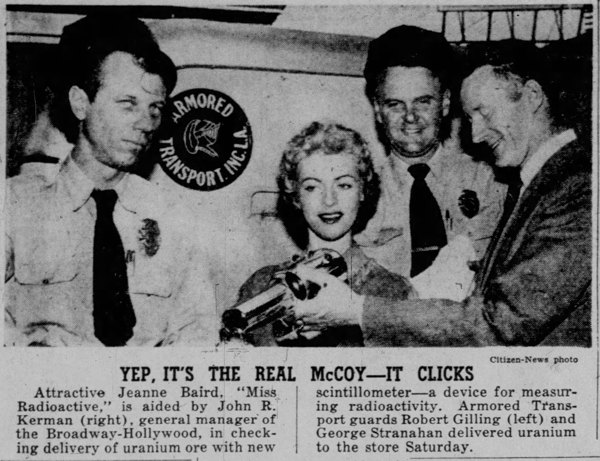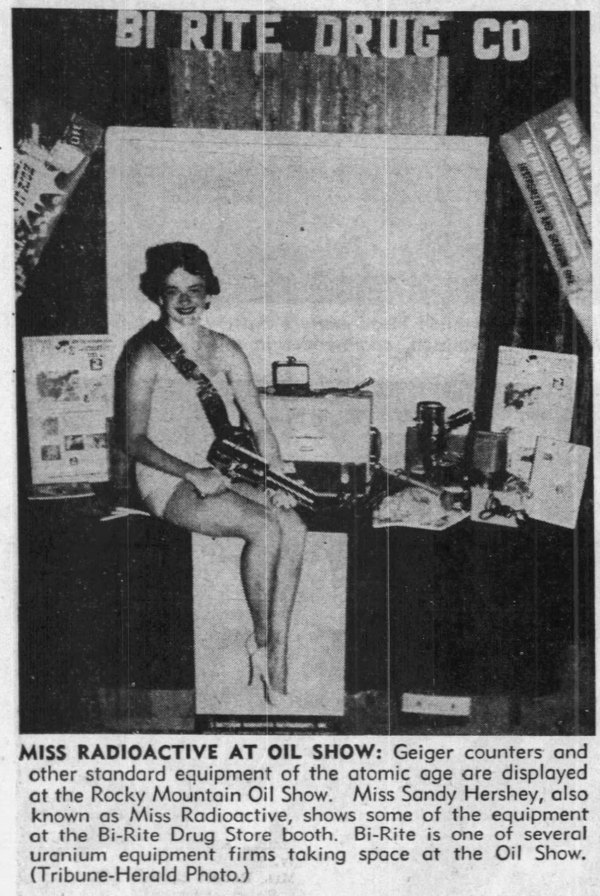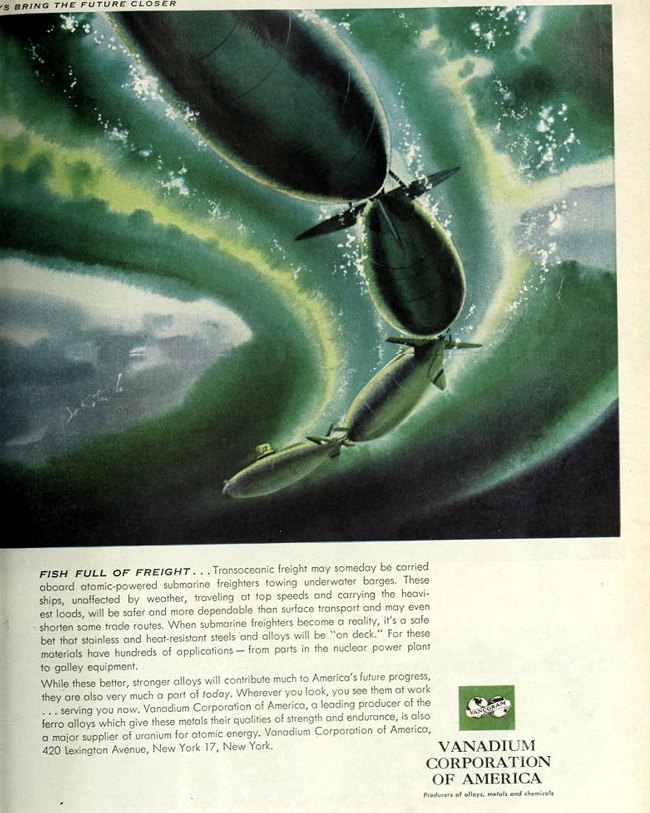Atomic Power and Other Nuclear Matters
Reassuring news in the event of a nuclear war
The reassuring news, according to Dr. G.D. Kersley, was that if you've had one nuclear bomb dropped on you, you're unlikely to have another.Kersley's article appeared in the Aug 9, 1958 issue of the British Medical Journal. You can read it here. The reassuring comments are on the final page, in the conclusions section.

Birmingham Post - Aug 8, 1958
Posted By: Alex - Mon Nov 06, 2023 -
Comments (2)
Category: War, Weapons, Atomic Power and Other Nuclear Matters, 1950s
How to protect the home and family after a nuclear explosion
It'd be nice to think that it was the calm practicality of British housewives that saved the world from nuclear warfare.

Vancouver Sun - Nov 27, 1957

Westminster and Pimlico News - Feb 27, 1959
Posted By: Alex - Wed Nov 01, 2023 -
Comments (1)
Category: Atomic Power and Other Nuclear Matters, 1950s
Death Sand
Radiological warfare is the use of radiation as a weapon. "Death Sand" is a variant of this — the use of irradiated sand as a weapon. Details from Popular Science, Feb 1951.Airplanes for "death-sand" attacks could resemble those used for crop dusting and spreading fertilizer from the air. A British plane for the latter purpose has dropped five tons of chemicals in a single experimental flight.
To protect occupants from the cargo's radioactivity a death-sand plane would need heavy shielding. (After calculating its weight, one scientist suggested dropping the shielding instead of the RW agent on the enemy!) But shielding could be omitted if crewless planes, under radio control from accompanying aircraft, laid the sand.
Troops in an area sprinkles with death sand will have no choice but to get out. Those who remain will receive a fatal dose in anywhere from a few hours to several weeks, depending on the intensity of the radioactivity. Like victims of A-bomb radiation, they will suffer nausea, loss of hair, anemia, and hemorrhages. But those who flee at once will suffer no ill effects.



Posted By: Alex - Thu Sep 14, 2023 -
Comments (3)
Category: War, Weapons, Atomic Power and Other Nuclear Matters
Atomic Mittens
"Here is your complete shield against the dangers of atomic attack."
Super Science Stories - Aug 1951
Posted By: Alex - Sun Aug 20, 2023 -
Comments (1)
Category: Fashion, Atomic Power and Other Nuclear Matters, 1950s
Miss Radioactive
In 1955, two women (Jeanne Baird and Sandy Hershey) were separately named "Miss Radioactive." I can't find any evidence of this title being used before or after 1955.They both seem to be displaying the same type of radiation detector — a scintillometer. If, like me, you weren't aware of the difference between a Geiger counter and a scintillometer, you can read about it here.

Los Angeles Evening Citizen News - Feb 14, 1955

Casper Star Tribune - June 24, 1955
Posted By: Alex - Fri Jul 28, 2023 -
Comments (2)
Category: Awards, Prizes, Competitions and Contests, Atomic Power and Other Nuclear Matters, 1950s
Radioprotective Blancmange
Several years ago, Russian scientists developed a recipe for a blancmange that would help protect against radiation poisoning. The perfect dessert to serve in your bunker after a nuclear war. Details from Improbable.com:You can find the article by the Russian scientists here, but it's in Russian (except for the initial abstract).
Posted By: Alex - Fri Jun 23, 2023 -
Comments (1)
Category: Food, Jello, Atomic Power and Other Nuclear Matters
Fish Full of Freight
It's the 21st century and we don't have flying cars. Nor do we have atomic-powered submarine freighters towing underwater barges.However, this did remind me of the Russian scheme to use nuclear submarines as oil tankers.

Fortune - Feb 1959
Posted By: Alex - Sat Apr 22, 2023 -
Comments (1)
Category: Boats, Oceans and Maritime Pursuits, Atomic Power and Other Nuclear Matters, Transportation, 1950s, Yesterday’s Tomorrows
Woops!
A comedy about life after nuclear Armageddon.Fox cancelled the series in late November. At the time, it was ranked 105th out of 108 weekly shows [54]. Only 10 of the 13 produced episodes were aired; the last was broadcast on December 6th.
Posted By: Paul - Wed Mar 01, 2023 -
Comments (5)
Category: Humor, Ineptness, Crudity, Talentlessness, Kitsch, and Bad Art, Television, War, Atomic Power and Other Nuclear Matters, 1990s
Miss Electrical Wonderland
Miss Electrical Wonderland used a radioactive key to open 1950's Electrical Wonderland expo in San Francisco. The radioactivity of the key was sensed by a Geiger counter that then triggered a man-made bolt of lightning to flash between two towers in the auditorium.
San Francisco Examiner - Sep 18, 1950

San Francisco Examiner - Sep 18, 1950
However, the identity of Miss Electrical Wonderland was, for some reason, switched at the last minute. The pre-show publicity stated that Janet Jackson was Miss Electrical Wonderland, and a photo (above) showed her handling the radioactive key bare-handed.
However, the news on the day of the opening stated that Elaine Doyle was now Miss Electrical Wonderland, and that she "gingerly lifted a radioactive copper key from its lead lined box with a pair of long handled tongs."
Why the switch? Gotta wonder if Janet Jackson was recovering from radiation burns.

San Francisco Examiner - Sep 24, 1950
Posted By: Alex - Sun Jan 08, 2023 -
Comments (2)
Category: Awards, Prizes, Competitions and Contests, Atomic Power and Other Nuclear Matters, 1950s
Blast-Resistant House

Posted By: Alex - Fri Dec 30, 2022 -
Comments (1)
Category: Architecture, Advertising, Atomic Power and Other Nuclear Matters, 1950s

| Who We Are |
|---|
| Alex Boese Alex is the creator and curator of the Museum of Hoaxes. He's also the author of various weird, non-fiction, science-themed books such as Elephants on Acid and Psychedelic Apes. Paul Di Filippo Paul has been paid to put weird ideas into fictional form for over thirty years, in his career as a noted science fiction writer. He has recently begun blogging on many curious topics with three fellow writers at The Inferior 4+1. Contact Us |




